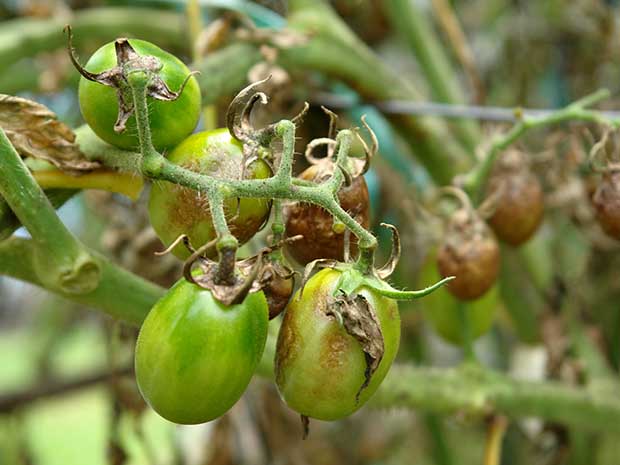When you look up Tomato Blight on the internet, what you’ll usually run into are long University papers and articles relating to crops. It’s a little difficult to sort through and find the information pertinent to your patio tomato or a few tomato plants in a raised bed. My mission here is to give you a quick overview and a solution for you, the home gardener.
There are 3 kinds of Tomato Blight: Early Blight, Late Blight, and Septoria, which is also considered a blight. All three are fungal diseases and treatment for all three is the same.
Early blight – Early to mid-season
What Does It Look Like?
Leaves will develop brown spots on lower leaves and stems. Lower leaves will often turn yellow and drop off.
Why Did It Happen?
Wet weather is usually the culprit for Early Blight. The fungus Alternaria solani loves damp and wet weather in order to grow.
What Can I Do About It?
Remove all affected leaves on the plant and dispose of them away from the garden. The treatment is organic, Copper Fungicide. Completely douse the plant with Copper and continue to use every week and particularly after heavy rains.
How Can I Prevent It?
If you had any blight last year, don’t plant in the same area this year or use the same soil in your raised bed or container.
Planting in raised beds goes a long way to prevent blight. Otherwise, make sure your tomatoes have good drainage.
Watering the soil and not the plant itself helps immensely.
Space plants so there is lots of air circulation. This gives the plant a chance to dry more quickly after rains.
Weak plants invite diseases. Follow good initial practices to grow healthy plants.
Late Blight – Mid to late season
What Does It Look Like?
Leaves develop blue-gray spots that then turn brown. White mold rings also appear on the spots. Leave will drop and brown, greasy spots develop on the fruit.
Why Did It Happen?
Wet weather is usually the culprit for Late Blight. The fungus Phytophthora infestans loves damp and wet weather in order to grow. Rain and winds can spread it.
What Can I Do About It?
Remove all affected leaves on the plant and dispose of them away from the garden. The treatment is organic, Copper Fungicide. Completely douse the plant with Copper and continue to use every week and particularly after heavy rains.
How Can I Prevent It?
If you had any blight last year, don’t plant in the same area this year or use the same soil in your raised bed or container.
Planting in raised beds goes a long way to prevent blight. Otherwise, make sure your tomatoes have good drainage.
Watering the soil and not the plant itself helps immensely.
Space plants so there is lots of air circulation. This gives the plant a chance to dry more quickly after rains.
Weak plants invite diseases. Follow good initial practices to grow healthy plants.
Septoria early to mid-season
What Does It Look Like?
You will find yellow spots on the undersides of lower leaves moving to leaf tops. Small black or brown spots will appear within the yellow spots, and then enlarge. Lower leaves will turn yellow and drop off.
Why Did It Happen?
Wet weather is usually the culprit for Septoria. The fungus Septoria lycopersici loves damp and wet weather in order to grow.
What Can I Do About It?
Remove all affected leaves on the plant and dispose of them away from the garden. The treatment is organic, Copper Fungicide. Completely douse the plant with Copper and continue to use every week and particularly after heavy rains.
How Can I Prevent It?
If you had any blight last year, don’t plant in the same area this year or use the same soil in your raised bed or container.
Planting in raised beds goes a long way to prevent blight. Otherwise, make sure your tomatoes have good drainage.
Watering the soil and not the plant itself helps immensely.
Space plants so there is lots of air circulation. This gives the plant a chance to dry more quickly after rains.
Weak plants invite diseases. Follow good initial practices to grow healthy plants.
Printable version of Tomato Blight

